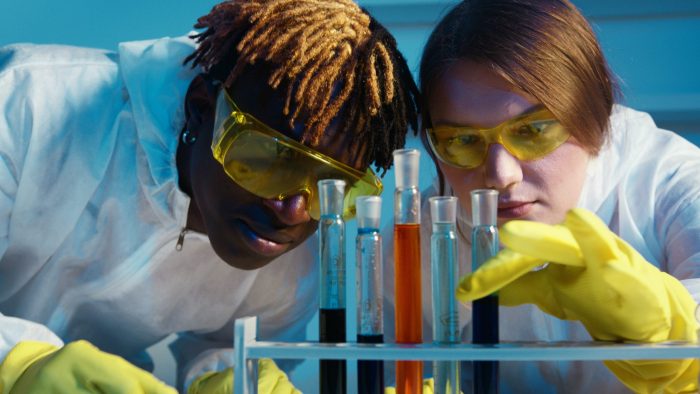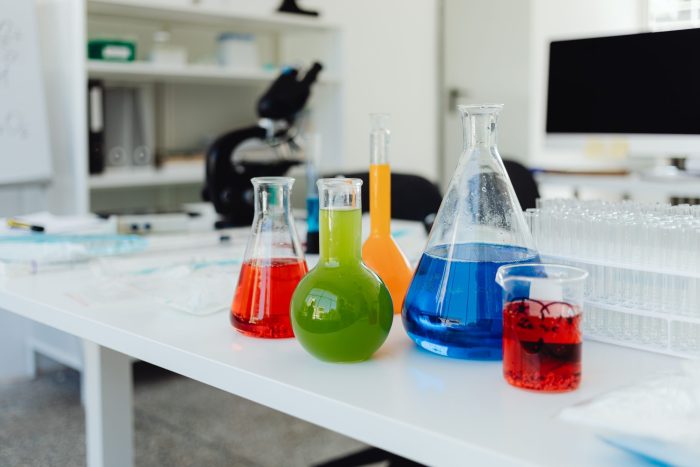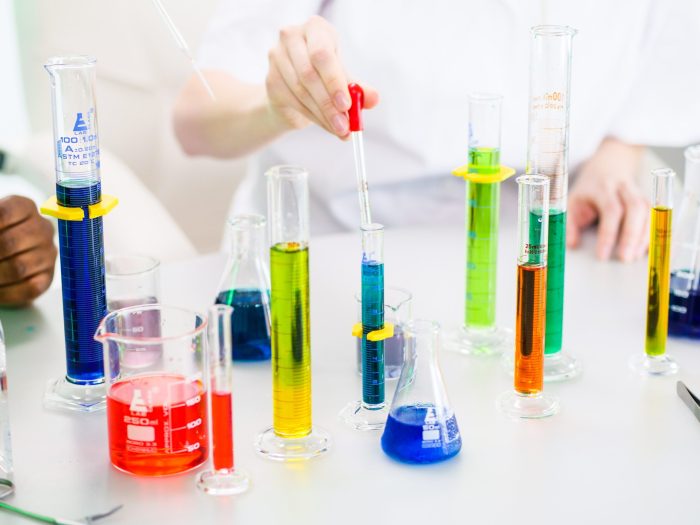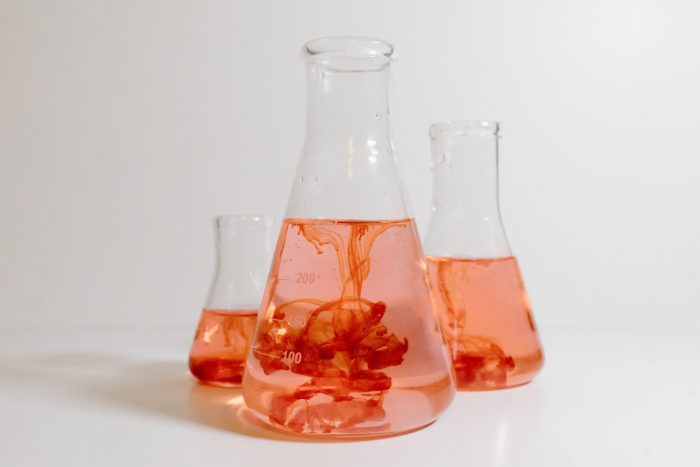Have you ever wanted to cook fun food or do a crazy science experiment with your child only to find that you’re missing an ingredient or tool? This happens to me far too often, and it’s SO frustrating! I love being spontaneous and creative with learning, but I always seem to be lacking an item or two.
When teaching homeschool chemistry to your high schooler, we hope you are utilizing labs—and a lot of them! Labs are a crucial part of teaching chemistry and a fun way to engage high schoolers, but they often come with a daunting list of “needed supplies.” And, after purchasing curriculum and other school supplies, you might look at that chemistry tools list and think “no way I’m buying all that.”

The good news is, you don’t have to! You can still offer engaging and educational labs to your homeschooled students with just the basics (plus any other household items you already have!) Here are 12 must-have homeschool chemistry lab supplies to get high school science off to a great start!
12 Must-Have Homeschool Chemistry Supplies
1. Safety Gear
Although the rest of this list is in no particular order, safety gear is intentionally holding the #1 spot! When working with chemicals, heat, and glass, safety gear is essential. This includes safety goggles, chemical-safe gloves, and even a lab coat! Not only will your student look like a real chemist, but they’ll be protected from any dangerous chemical reactions.
2. Test Tubes

These small glass tubes are similar to a cylinder shape but are closed on one end and open on the other. They need to be stored in a test tube rack, even when in use, because they cannot stand up on their own. Test tubes are used in many ways in chemistry, with the primary way being to hold and evaluate small amounts of liquid substances. Test tubes can be heated, but only if they don’t have a cap on them!
3. Thermometer
Unlike the typical under-your-arm thermometer used to check for fevers, laboratory thermometers are used to measure the temperature of liquids. Some are glass with manual reading, while others are made of stainless steel and have a digital output. Lab thermometers range significantly in price, but you can still find adequate options at a very affordable cost!
4. pH Paper
Another very affordable chemistry tool! pH paper measures a wide range of acidic and alkaline solutions. In many chemistry experiments, your student will need to determine whether a solution, is acidic, basic, or neutral. pH paper makes this quick, easy, and safe!
5. Graduated Cylinders
This tool is one of the first that comes to my mind when I think of chemistry lab supplies. Unlike a test tube, a graduated cylinder can stand on its own and has units of measurement. It goes beyond just holding liquids and aids in measurement. Graduated cylinders come in many different sizes!
6. Beakers
A beaker resembles a mini glass pitcher (but with no handle!) and can be used on a hot plate to heat liquids. Because it has a much larger diameter than test tubes and cylinders, beakers are perfect for mixing and stirring liquids with a lesser risk of spillage.
7. Laboratory Scoop
A quality stainless-steel laboratory scoop is essential for handling chemicals. These scoops are specially designed to scoop the tiny amounts of chemicals you’ll likely need out of bottles and onto your scale to get precise measurements.
8. Scale
Just like I use a scale in cooking to measure the exact number of grams of flour needed for sourdough bread, so are chemistry scales used for measuring components in the lab! Keep in mind that scales might seem expensive at first, but there are plenty of inexpensive options available!
9. Hot Plate
The name gives it away! Hot plates are electronically heated flat surfaces that are similar to a glass stovetop but with a much more precise heating element. The liquid contained in beakers is commonly heated using a bunsen burner or hot plate, and you can set the beaker directly on the hot plate! I often think of a hot plate as a pancake griddle—but for chemistry! And, unlike gas burners, there is no open flame involved with a hot plate.
10. Tongs and Forceps
When working with delicate and/or hot containers, tongs and forceps are ideal tools for safe handling. Even if wearing gloves, there are often containers that you shouldn’t hold with your hands. Similarly, if you need to use solid chemicals in the lab, forceps allow you to move these solids around without using your hands and risking injury to your skin.
11. Erlenmeyer Flasks
Here we have yet another glass container! You’re going to need a label maker to keep all of these straight! The Erlenmeyer flask has a narrow neck but a wide base. This makes it even better for mixing and stirring, compared to a beaker, because less spillage will result from swirling the liquid in the flask. This tool can be heated on a hot plate and has a very low risk of being knocked over, once again due to its unique shape.
12. Droppers
Unlike a pipette, droppers are not accurate tools to measure small amounts of liquid. They are, however, an excellent way to disperse liquid in one-drop increments. As you may already know, droppers are used in many other fields beyond chemistry and are very easy to purchase!
When and Where to Buy Homeschool Chemistry Supplies
Now that you have a list of must-have homeschool chemistry supplies, when are you supposed to buy these and where? Surprisingly, the purchase options are vast!

If your high schooler is enrolled in chemistry for the upcoming school year, now is a great time to buy chemistry supplies and let you and your student get familiar with each tool. If you already started chemistry and are just now realizing that you need to purchase supplies, it’s never too late to order them, especially if you have other students who will use these tools in the years to come.
At Journey Homeschool Academy, our high school chemistry course, Experience Chemistry, highly encourages the importance of labs but also understands the stress that can come with purchasing chemistry supplies. That’s why we offer a chemistry lab supplies list that you can view before using our curriculum. You’ll be pleasantly surprised to see that most of the items are available in most online science supply stores.
We understand supplies can get expensive, so we have alternatives to help you stay on a budget — contact us to learn about the labs that use the least expensive supplies and your student can watch our online video demonstrations to complete the remaining labs.
If you’re looking for an all-in-one purchase option, Cornerstone Educational Supply has put together a chemistry science kit that contains every single tool, chemical, and safety item needed to successfully complete our lab guide through Experience Chemistry. It’s a wonderful time saver. Or you can pick and choose which supplies to buy and purchase your supplies a la carte through Home Science Tools.

Whatever you do, keep doing science labs!
Labs are truly one of the best ways to teach your high schooler about chemistry, and with an assortment of homeschool chemistry supplies, learning and discovery can go so far outside of baking soda reactions and carbonated soda rockets! The concepts taught will be carried over to other sciences and will equip your high schooler with so many skills beyond chemistry. Head to your homeschool chemistry lab, and have fun!
Looking for recommendations on what to buy for other science courses?
Check out our guide to buying the best microscopic for homeschool biology and our list of 12 must-have tools for basic homeschool science!



